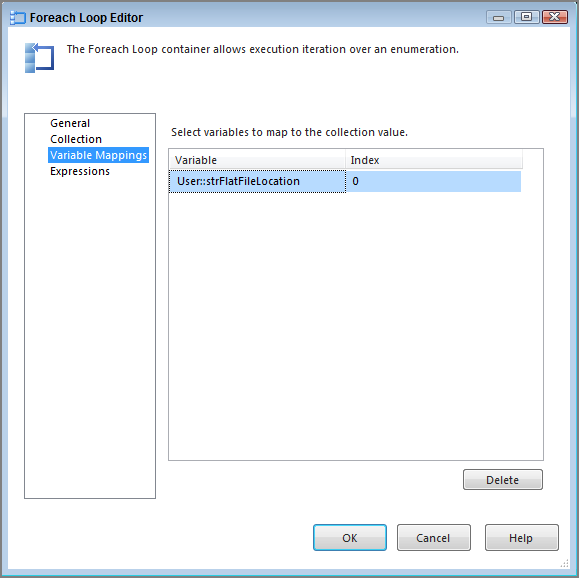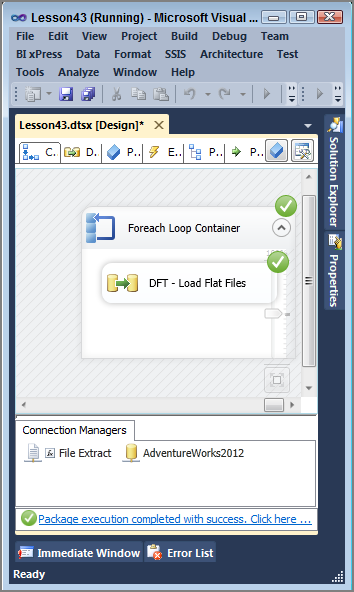Chapter 43
Using the Foreach Loop Container to Loop Through a Collection of Objects
The Foreach Loop Container is a very powerful and very useful tool for repeating Control Flow items. It is often used when you have a collection of files to which you want to apply the same changes. If you provide the directory for a set of files, the Foreach Loop Container can apply the same Control Flow tasks to each file. You might ask yourself, how is this different from the For Loop Container? The easy answer is that the For Loop iterates through the content of the container a number of times you define or you define with an expression, whereas the Foreach Loop Container iterates through its content as many times as it takes to effect the full collection.
The configuration of the Foreach Loop Container can differ depending on which enumerator you decide to use. An enumerator specifies the collection of objects that the container will loop through. All tasks inside the container will be repeated for each member of a specified enumerator. The Foreach Loop Editor can significantly change depending on what you set for this option:
- Foreach File Enumerator—Performs an action for each file in a directory with a given file extension
- Foreach Item Enumerator—Loops through a list of items that are set manually in the container
- Foreach ADO Enumerator—Loops through a list of tables or rows in a table from an ADO recordset
- Foreach ADO.NET Schema Rowset Enumerator—Loops through an ADO.NET schema
- Foreach From Variable Enumerator—Loops through a SQL Server Integration Services (SSIS) variable
- Foreach Nodelist Enumerator—Loops through a node list in an XML document
- Foreach SMO Enumerator—Enumerates a list of SQL Management Objects (SMO)
To configure the Foreach Loop Container, drag it on the design surface and double-click the top portion of the container to open the editor. Click the Collection tab to choose which type of enumerator you want to use, as shown in Figure 43-1. For example, say you want to loop through a directory to load a group of flat files to a table, so you choose the Foreach File Enumerator. Then you must specify what folder directory the files are in and what kind of file extension they have. Assume the flat files are .txt files, so in the Files box *.txt is used to bring back only the text files in the directory. Last, because the flat files each have a different name, you can use the Variable Mappings tab to dynamically change a variable value for each iteration of the loop. That variable then can pass the correct file name to the Flat File Connection with an expression. Don’t worry if this explanation sounds complicated because the following “Try It” section gives you a step-by-step example of how to do this exact scenario.
Another commonly used enumerator is the Foreach ADO Enumerator. This enumerator is handy for looping through a set of records and executing every task inside the container for each record in that set. For example, you want to run each task in your package for every database on a server. With the Foreach ADO Enumerator, you could loop through a table that lists all the database names on your server and dynamically change a connection manager’s database name for each iteration of the loop.
Try It
In this Try It, you create a package that uses the most common type of enumerator, the Foreach File Enumerator, to loop through a collection of flat files and load them to a table. After this lesson, you will understand how to use the Foreach Loop Container to loop through a collection of files and load each to a table.
You can download the completed Lesson43.dtsx and the sample files used in this lesson from www.wrox.com.
Lesson Requirements
Download the four flat files named File 1.txt, File 2.txt, File 3.txt, and File 4.txt from www.wrox.com to use as your source. Save these files to the C:ProjectsSSISPersonalTrainerLesson 43 directory.
Create a table named ForEachLoop in the AdventureWorks2012 database to load each flat file into.
Use a Foreach Loop Container to loop through and load each file in the C:ProjectsSSISPersonalTrainerLesson 43 directory.
Hints
- Create a variable to store the location of the file that currently needs to be loaded. The loop will change the variable location after each run.
- Use this variable as an expression for the connection manager that points to the flat file.
Step-by-Step
CREATE TABLE [ForEachLoop] (
[Name] varchar(50),
[State] varchar(50)
)






